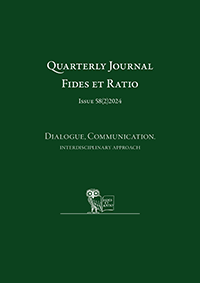Abstract
Nowadays, children increasingly choose screen devices as a form of communication and spending free time, which raises concerns about the potential harmfulness of excessive use of them. Therefore, it seems important to look at the issue of using screen devices from the perspective of parents and their attitudes towards children themselves, as well as in relation to the use of screen devices in everyday life. The aim of the presented study was to demonstrate the relationship between parental attitudes, parent’s gender and the assessment of the benefits and risks associated with children’s screen devices use. The research tools used in the study included The Parental Attitudes Scale (SPR) by Mieczyslaw Plopa (2008), covering six parental attitudes, and original The Screen Usage Questionnaire (KKE) to measure the attitude towards screen use by children. The article discusses theoretical aspects of parental attitudes towards children and screen use, as well as the benefits and risks of children’s screen devices use in the early primary school years. The operationalization of variables in research tools was presented. The study involved 173 participants aged 29-44 years (M = 36.56; SD = 3.16; Me = 37), including 127 mothers and 47 fathers of children aged 7-10 from the Podkarpackie. No correlation was found between parental attitudes and their assessment of the benefits and risks associated with screen devices use. However, the differences were observed between mothers and fathers in the assessment of benefits and risks. The research results indicate the need for education on digital parenting. Mothers assessed the use of screens neutrally or negatively, while fathers assessed it neutrally or positively, hence the conclusion regarding preventive activities is to direct various educational interventions towards fathers and mothers. These findings indicate the need to support parents introducing children to the digital world in effective education regarding the use of screen devices.
References
Aronson, E. (2012). Człowiek istota społeczna. Warszawa: Wydawnictwo Naukowe PWN.
Brief (2020). IQS i Gameset: Kobiety stanowią 47% graczy w Polsce. https://brief.pl/iqs-i-gameset-kobiety-stanowia-47-graczy-w-polsce/ (dostęp: 09.04.2024).
Byrne, S., Katz, S.J., Lee, T., Linz, D., McIlrath, M. (2014). Peers, predators, and porn: Predicting parental underestimation of children’s online risky experiences. Journal of Computer-Mediated Communication, 19, 215-231. http://dx.doi.org/10.1111/jcc4.12040
Dębski, M., Bigaj, M. (2019). Młodzi cyfrowi. Nowe technologie. Relacje. Dobrostan. Gdańsk: GWP. https://dbamomojzasieg.pl/wp-content/uploads/2019/12/Mlodzi-Cyfrowi.-Nowe-technologie.-Relacje.-Dobrostan_ksiazka.pdf (dostęp: 09.04.2024).
Fijałkowska, A. (2021). Czy zawsze warto być trendy? (w:) M. Nykiel (red.), Cyfrowe dzieciństwo. Jak chronić dziecko w sieci?, 22-27, Kraków: SOCIALPRESS.
Internet Matters (2022). Dobrostan dzieci w cyfrowym świecie: raport indeksowy 2022. https://www.internetmatters.org/pl/hub/news-blogs/internet-matters-launches-childrens-wellbeing-in-a-digital-world-index-report-2022/ (dostęp: 09.04.2024).
Kardaras, N. (2018). Dzieci ekranu. Jak uzależnienie od ekranu przejmuje kontrolę nad naszymi dziećmi i jak wyrwać je z transu. Warszawa: CeDeWu.
Klichowski, M., Pyżalski, J., Kuszak, K., Klichowska, A. (2017). Jak technologie informacyjno-komunikacyjne mogą wspierać rozwój dziecka w wieku przedszkolnym? Studium teoretyczne. (w:) J. Pyżalski (red.), Małe dzieci w świecie technologii informacyjno-komunikacyjnych - pomiędzy utopijnymi szansami a przesadzonymi zagrożeniami, 115-157. Łódź: Wydawnictwo „Eter”.
Krzyżak-Szymańska, E. (2018). Uzależnienia technologiczne wśród dzieci i młodzieży. Kraków: Oficyna Wydawnicza Impuls.
Lenhart, A., Arafeh, S., Smith, A., Macgill, A. (2008). Writing, technology and teens. Pew Internet & American Life Project. https://files.eric.ed.gov/fulltext/ED524313.pdf (dostęp: 09.04.2024).
Mróz, A., Solecki, R. (2017). Postawy rodziców wobec aktywności nastolatków w internecie w percepcji uczniów. E-mentor, 4(71), 19-24. http://dx.doi.org/10.15219/em71.1316
Ofcom (2017). Children and parents: Media use and attitudes report. https://www.ofcom.org.uk/__data/assets/pdf_file/0020/108182/children-parents-media-use-attitudes-2017.pdf (dostęp: 09.04.2024).
Oleszkowicz, A., Senejko, A. (2013). Psychologia dorastania. Zmiany rozwojowe w dobie globalizacji. Warszawa: Wydawnictwo Naukowe PWN.
Plopa, M. (2008). Więzi w małżeństwie i rodzinie. Metody badań. Kraków: Oficyna Wydawnicza Impuls.
Przybyła-Basista, H., Kołodziej-Zaleska, A. (2018). Fascynacja dzieci Internetem a rodzicielski monitoring ich aktywności online. Zeszyty Naukowe Politechniki Śląskiej. Organizacja i Zarządzanie, 123, 443-460.
Ptaszek, G., Stunża, G.D., Pyżalski, J., Dębski, M., Bigaj, M. (2020). Edukacja zdalna: co stało się z uczniami, ich rodzicami i nauczycielami? Gdańsk: Gdańskie Wydawnictwo Psychologiczne.
Pyżalski, J., Zdrodowska, A., Tomczyk, Ł., Abramczuk, K. (2019). Polskie badanie EU Kids Online 2018. Najważniejsze wyniki i wnioski. Poznań: Wydawnictwo Naukowe UAM. https://fundacja.orange.pl/files/user_files/EU_Kids_Online_2019_v2.pdf (dostęp: 09.04.2024).
Spitzer, M. (2013). Cyfrowa demencja. W jaki sposób pozbawiamy rozumu siebie i swoje dzieci. Słupsk: Wydawnictwo Dobra Literatura.
Symons, K., Ponnet, K., Emmery, K., Walrave, M., Heirman, W. (2017). Parental knowledge of adolescents’ online content and contact risks. Journal of Youth and Adolescence, 46(2), 401-416. https://doi:10.1007/s10964-016-0599-7
Tosun, N., Mihci, C. (2020). An examination of digital parenting behavior in parents with preschool children in the context of lifelong learning. Sustainability, 12(18), http://dx.doi.org/10.3390/su12187654
Uhls, Y.T. (2016). Cyfrowi rodzice. Dzieci w sieci. Jak być czujnym, a nie przeczulonym. Kraków: IUVI.
Urząd Komunikacji Elektronicznej (2021). Badanie opinii publicznej w zakresie funkcjonowania rynku usług telekomunikacyjnych oraz preferencji konsumentów. Raport z badania dzieci i rodziców. https://uke.gov.pl/download/gfx/uke/pl/defaultaktualnosci/36/412/8/2021__raport_uke_dzieci_rodzice.pdf (dostęp: 09.04.2024).
Valcke, M., Bonte, S., De Wever, B., Rots, I. (2010). Internet parenting styles and the impact on internet use of primary school children. Computers and Education, 55, 454-464. https://doi.org/10.1016/j.compedu.2010.02.009
Wojciszke, B. (2005). Postawy i ich zmiana. (w:) J. Strelau (red.), Psychologia. Podręcznik akademicki, 79-106. Gdańsk: GWP.
Wojtasik, Ł., Dziemidowicz, E. (2019). Urządzenia ekranowe w rękach dzieci w wieku 0–6 lat – zagrożenia, szanse, postulaty profilaktyczne. Dziecko krzywdzone. Teoria, badania, praktyka, 18(2), 106–119.
Ziemska, M. (1986). Postawy rodzicielskie i ich wpływ na osobowość dziecka. (w:) M. Ziemska (red.), Rodzina i dziecko, 155-195. Warszawa: Wydawnictwo Naukowe PWN.
Zimbardo, P.G., Gerrig, R.J. (2018). Psychologia i życie. Warszawa: Wydawnictwo Naukowe PWN.

